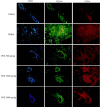Suppression of hypoxia and inflammatory pathways by Phyllanthus niruri extract inhibits angiogenesis in DMBA-induced breast cancer mice
- PMID: 34084208
- PMCID: PMC8102930
- DOI: 10.4103/1735-5362.310528
Suppression of hypoxia and inflammatory pathways by Phyllanthus niruri extract inhibits angiogenesis in DMBA-induced breast cancer mice
Abstract
Background and purpose: Angiogenesis has been one of the hallmarks of cancer. In recent years, Phyllanthus niruri extract (PNE) was reported to inhibit angiogenesis by decreasing the levels of vascular endothelial growth factor (VEGF) and hypoxia-inducible factor-1α (HIF-1α) in breast cancer. However, the experimental results were confirmed in cancer cell lines only, whereas the anti-angiogenic activity in animal models has not been demonstrated. In this study, we tried to examine the anti-angiogenic activity of PNE on BALB/c strain mice models that were induced for breast cancer using the carcinogenic substance 7,12- dimethylbenz[a]anthracene (DMBA).
Experimental approach: Experimental animals were divided into five different groups; vehicle, DMBA, PNE 500 mg/kg, PNE 1000 mg/kg; and PNE 2000 mg/kg. Mammary carcinogenesis was induced using a subcutaneous injection of 15 mg/kg of DMBA for 12 weeks. Afterward, oral PNE treatment was given for the following 5 weeks. VEGFA and HIF-1α were observed using immunohistochemistry. Endothelial cell markers CD31, CD146, and CD34 were observed using the fluorescent immunohistochemistry method. The levels of interleukin-6 (IL-6), IL-17, and C-X-C motif chemokine (CXCL12) were measured using flow cytometry.
Findings/results: The survival analysis indicated that PNE increased the survival rate of mice (P = 0.043, log-rank test) at all doses. The PNE treatment decreased the immunoreactive score of angiogenic factors (VEGF and HIF-1α), as well as the endothelial cell markers (CD31, CD146, and CD34). The PNE- treated groups also decreased the levels of inflammatory cytokines (IL-6, IL-17, and CXCL12) at all doses.
Conclusion and implications: This finding suggests that PNE may inhibit the progression of angiogenesis in breast cancer mice by targeting the hypoxia and inflammatory pathways.
Keywords: Angiogenesis; Breast cancer; DMBA; Inflammation; Phyllanthus niruri.
Copyright: © 2021 Research in Pharmaceutical Sciences.
Conflict of interest statement
The authors declared no conflict of interest in this study.
Figures





References
-
- Gatenby RA, Gillies RJ. Why do cancers have high aerobic glycolysis. Nat Rev Cancer. 2004;4(11):891–899. DOI: 10.1038/nrc1478. - PubMed
-
- Potente M, Gerhardt H, Carmeliet P. Basic and therapeutic aspects of angiogenesis. Cell. 2011;146(6):873–887. DOI: 10.1016/j.cell.2011.08.039. - PubMed
-
- Vaupel P, Höckel M, Mayer A. Detection and characterization of tumor hypoxia using pO2 histography. Antioxid Redox Signal. 2007;9(8):1221–1235. DOI: 10.1089/ars.2007.1628. - PubMed
-
- Murugaiyan G, Saha B. Protumor vs antitumor functions of IL-17. J Immunol. 2009;183(7):4169–4175. DOI: 10.4049/jimmunol.0901017. - PubMed
LinkOut - more resources
Full Text Sources
